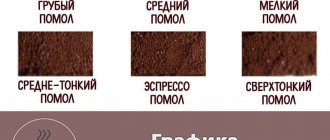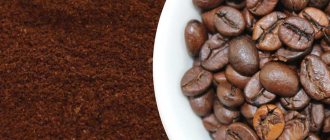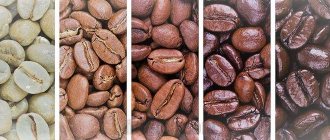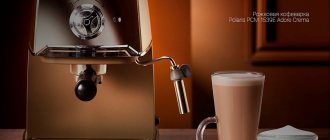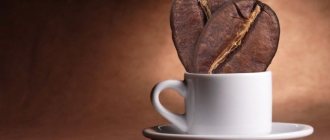Coffee is an aromatic drink with a unique taste that is drunk all over the world. There are a huge number of varieties, methods of roasting and preparing this drink, and coffee experts understand all the intricacies of taste and aroma no less than sommeliers.
To determine which ground coffee is the best, you should first pay attention to the manufacturer. Despite the fact that coffee plantations are located in Brazil, Colombia, India, Latin America, Asia and so on, it is better to choose European producers, because they are better versed in the intricacies of taste, grinding, and roasting.
A good product has airtight packaging to preserve the aroma for a long time. Well, the type, grind size, and degree of roasting should be chosen based on taste preferences and cooking method.
What types of grinding are there?
When we buy coffee beans, we mentally already anticipate how we will enjoy the rich taste of the drink and its noble aroma. But very often, even if the recipe is followed, the coffee turns out to be too bitter or thin, and sometimes it smells terribly burnt.
Remember: in this case, you should not always blame the seller or manufacturer. Often the reason for an unsuccessfully brewed drink is due to improper grinding of the coffee.
So what should it be then? How exactly to grind? In fact, everything is simple here: grinding directly depends on what and where you are going to brew the drink.
Grinding for Turks
When using Turkish coffee, I recommend brewing ultra-fine ground coffee: the finest grind, more like dust. The grain particles thus form a suspension, making the drink thick. You just need to wait until it settles completely.
At home, grinding grains so finely is almost impossible. Therefore, it is best to buy ready-made ultrafine ground coffee or grind it in specialized coffee shops and stores. Coffee powder should be used as soon as possible: it wears out quite quickly, literally within a few hours.
Espresso grinder
A fine espresso grind was invented especially for coffee machines: it is slightly finer than the usual fine grind, but larger than the extra-fine grind. Externally it resembles table salt.
It is the most difficult to choose, because... Such grinding greatly depends on the capabilities of a particular coffee machine. The same ground coffee may be too fine, for example, for De'Longhi (it will not be able to press through) and too coarse for Bork (the drink will turn out liquid).
There are no standards for fine grinding of espresso, so I advise you to select it experimentally. To do this, brew coffee and evaluate the extraction rate. The ideal preparation time for 25 ml of espresso is 25 seconds. An error of no more than ± 3 seconds is allowed.
If the drink flows out too slowly (25 ml is not collected in 28 seconds), and the stream of coffee is thin and intermittent, then the grind is too fine. If the portion comes out faster than 22 seconds, it means the grind is too coarse and the drink is not strong.
Aeropress grinding
If you are the proud owner of an AeroPress, then your grind should be slightly coarser than for espresso, but finer than for filter coffee makers, Hario V60 and pour over. The fraction size is like cane sugar, fine and medium.
I also recommend keeping in mind that the finer the grind, the stronger the coffee. But at the same time, ultra-fine grinding powder will clog the AeroPress filter, so be extremely careful.
Grinding for filter coffee maker, Hario V60 and pour over
Medium grind coffee is suitable here, the size of the fraction is the same as that of granulated sugar. It should be a little larger than for an Aeropress. It is believed that this grind is the most versatile and unpretentious, so if you think it is too fine or coarse, then simply use a little less or more coffee in the recipe.
If you are using disposable paper filters, you may prefer a smaller grind size to allow water to pass through the grounds. But keep in mind that finely ground coffee cannot be brewed in pour-overs with metal or fabric filters. In this case, grain particles will simply fall through the holes.
Grinding for geyser coffee makers and Chemex
Here I advise you to take the grind a little coarser than the previous one. Externally, it should look like fine sea salt or sugar crystals, and feel like sand.
Fine grinding in such coffee makers can be very bitter, and the consistency will be watery, close to tea.
Grinding for filter coffee maker and Cold Brew
And in this case, there is no need to grind! Here I suggest using the coarsest grind, the size of which can reach buckwheat or pearl barley. Outwardly, it should look almost like crushed coffee. Such grain particles are easily retained in the device and do not fall into the cup.
TOP 4 medium ground coffee
| Photo | Name | Rating | Price | |
| #1 | Lavazza Crema e Gusto | ⭐ 4.9 / 5 6 — votes | More details | |
| #2 | Julius Meinl Viennese breakfast | ⭐ 4.7 / 5 2 - votes | More details | |
| #3 | Julius Meinl President | ⭐ 4.5 / 5 | More details | |
| #4 | Jardin Americano Crema | ⭐ 4.25 / 5 4 - votes | More details |
Which of the presented coffees did you like best?
Take the survey
Medium grind coffee is a drink with a classic taste of medium strength. It is best to drink it for breakfast or after lunch, as this coffee has a strong tonic effect. Good additions to medium-ground coffee are lemons, cream and desserts based on natural berries.
No. 4 – Jardin Americano Crema
One of the most popular brands of ground coffee. Jardin Americano Crema coffee has a soft and harmonious taste and a rich caramel shade due to low roasting. A special feature of the finished drink is the presence of dense creamy foam. Arabica beans are used in production (more than 90%), and the taste is diluted with notes of robusta, resulting in a delicate and tart aftertaste after drinking the drink.
Characteristics of Jardin Americano Crema coffee:
- variety – Arabica/Robusta;
- grinding – medium;
- degree of roasting – light;
- average cost – 181 rubles per pack of 250 g.
pros
- high Arabica content;
- soft and harmonious taste;
- delicate creamy foam;
- affordable price.
Minuses
- not identified.
Reviews and prices for Jardin Americano Crem coffee
No. 3 – Julius Meinl President
Julius Meinl President is one of the most popular brands of medium ground coffee. This is premium coffee with a bright, memorable taste, made from high-quality high-mountain Arabica beans. All products from this manufacturer are produced in tight vacuum packaging, which allows you to preserve all the taste and aroma as much as possible. Julius Meinl President has a slightly bitter aftertaste and slight sourness, as it contains 15% robusta.
Characteristics of coffee Julius Meinl President:
- variety – Arabica 85%, Robusta 15%;
- grinding – medium;
- degree of roasting – medium;
- average cost – 287 rubles per pack of 250 g.
pros
- contains high quality grains.
Minuses
- not identified.
Coffee prices Julius Meinl President
Coffee Julius Meinl President
No. 2 – Julius Meinl Viennese breakfast
Julius Meinl Viennese Breakfast
Another type of coffee from the manufacturer Julius Meinl. It has a tart taste with a piquant bitterness and is high in strength, so it is recommended to drink it during an early breakfast to invigorate and recharge your batteries. The strength is ensured by the high content of robusta, as well as Italian (dark) roasting.
Characteristics of Julius Meinl Viennese Breakfast coffee:
- variety – Arabica 75%, Robusta 25%;
- grinding – medium;
- degree of roasting – dark;
- average cost – 348 rubles per pack of 250 g.
pros
- helps to wake up in the morning or cheer up after hard mental work.
Minuses
- very strong;
- The taste is not for everyone (according to customer reviews, it is very bitter).
Coffee prices Julius Meinl Viennese breakfast
Coffee Julius Meinl Viennese breakfast
No. 1 – Lavazza Crema e Gusto
One of the best brands of strong black coffee, medium grind, containing only 30% Arabica. Due to strong roasting, the drink turns out strong, rich and thick with dense foam.
Characteristics of Lavazza Crema e Gusto coffee:
- variety – Arabica 30%, Robusta 70%;
- grinding – medium;
- degree of roasting – dark;
- The average cost is 253 rubles per pack of 250 g.
pros
- excellent tart taste for lovers of strong coffee.
Minuses
- not identified.
Prices for Lavazza Crema e Gusto coffee
Coffee Lavazza Crema e Gusto
Where is the best place to buy ground coffee?
Surely you know that ground coffee dissipates much faster than coffee beans. Therefore, I do not recommend purchasing it in regular stores. In this case, there is a risk of stumbling upon a tasteless powder that has nothing in common with aromatic coffee. But what if you don’t have a coffee grinder at home, but want to have a cup of hot drink every day?
I know the way out! Get coffee at:
- In a specialty store or coffee shop, where it is ground right before your eyes . But don’t be greedy, take freshly ground coffee in small packets, which would be enough for about a week. In this case, it will not have time to run out of steam, and the degree of grinding will be exactly what you require.
- In an online store, at a roaster . Here you can be one hundred percent sure that the coffee will not only be freshly ground, but also freshly roasted. The big plus is that after placing an order, it will arrive to you in about 4-5 days. As I wrote earlier, it just needs that amount of time to rest after roasting, become rich and gain flavor. Freshly roasted ground coffee will last much longer than from a coffee shop or supermarket. In general, it does not lose its taste for about a month.
- In the supermarket . In large retail outlets, products, as a rule, do not sit on shelves and are constantly updated. Therefore, you can find good ground coffee there too. However, before purchasing, be sure to pay attention to the production date.
Coffee varieties
Very often, the concepts of variety and type of coffee are confused. The type of coffee is the type of coffee tree from which the beans are obtained. The most popular types:
- Arabica;
- Robusta;
- Liberica.
Arabica:
The official name is Coffee Tree of Arabia and it is the most popular type of coffee in the world. Has a rich multi-level aroma. This crop is very delicate - it loves mountain tropics with high humidity conditions. Perhaps that is why, by absorbing the aromas of the surrounding nature, it makes the greatest impression on coffee lovers. Currently there are more than 50 varieties of this species.
Robusta:
The official name is Canephora Robusta Coffee Tree. This type is revered by lovers of strong drinks, since Robusta contains the highest level of caffeine in its beans. It has a bitter taste, so it is usually used in coffee blends to add strength to the drink. The culture is less whimsical than Arabica. Loves low-lying tropics and constant rain.
Liberica:
Due to the scarcity of its harvest, it was not widely used. This type is mainly used in the countries where it grows: Indonesia, Sri Lanka, the Philippines, etc. They love it for its amazing aroma, superior even to the aroma of Arabica. Liberica is used in coffee blends to add more flavor. As for drinking a drink made from Liberica grains in its pure form, it is better not to do this, as the taste will be as bad as the aroma is wonderful. The drink brewed from these grains is not rich and not strong. This type is mainly used in the confectionery industry, which is why it ranks third in the ranking of popular types of coffee.
TOP 10 varieties of ground coffee
When producing and packaging ground grain, manufacturers must follow certain rules to preserve the freshness, taste and aroma of the future drink. This applies to both freshly roasted coffee and supermarket coffee.
However, few varieties can boast of strict adherence to these principles. Let's look at the best of them.
Freshly roasted coffee
1 Jack's Blend by Coffee Project
Find out more
Buy Holiday coffee from a roaster, created specifically to be ground. The varieties are grown in the Mogiana and Cerrado regions. The composition contains a set of spices taken from the recipe for traditional American pumpkin pie: cinnamon, cloves, nutmeg, ginger and others. It does not fade for a long time, maintaining a rich spicy taste with a hint of ginger, the sweetness of a nut and a minty aftertaste. The finished drink has a bright, rich aroma.
Advantages
- a lot of spices in the composition;
- does not run out of steam for a long time;
- with equal success it is prepared in a Turk, a geyser coffee maker, a French press, a filter coffee maker and brewed in a cup.
Flaws
- There may be an individual intolerance or an allergic reaction to the spices in the mixture.
2 Ethiopia Sidamo by Coffee Project
Find out more
Buy Coffee from a roaster with a light body and citrus sourness, the aroma of berry juice and spices with notes of cocoa. Sidamo is grown in central and southern Ethiopia and is considered one of the most popular varieties with great taste. It is possible to choose any grind. Ideal for espresso and filter coffee makers.
Advantages
- very bright and aromatic variety;
- It prepares well in almost all coffee machines and devices: French press, drip coffee maker, Aeropress, pour over or Chemex.
Flaws
- not the most budget option.
3 Colombia Willa La Virginia by Ingresso
Find out more
Buy Another coffee from a roaster, grown in Colombia at an altitude of 1800 meters above sea level. Processed using natural anaerobic fermentation, resulting in a persistent and vibrant cocoa aroma. It is a balanced coffee with clean acidity, a satiny, round, smooth body and a long finish.
Advantages
- SCA score – 85.5 points;
- pronounced cocoa aroma;
- Suitable for brewing in a drip coffee maker, Chemex, French press, Aeropress, pour over.
Flaws
- very sweet, not suitable for sour lovers;
- high price.
4 Breakfast Blend espresso mix from Coffee Project
Find out more
Buy A rich blend from a roaster with an enveloping fruity aroma of figs, dark raisins and a delicate aftertaste of sweet baked apple. Consists of two varieties of 100% Arabica. The base is a dark roasted Brazil Fine Cup, which gives the coffee a soft body and caramel sweetness. To enrich the taste, dark roasted coffee from Ethiopia Sidamo is added to the blend. It sets off the drink with a slight sourness and adds freshness. Great for making espresso.
Advantages
- rich taste, dense body with slightly perceptible sourness;
- affordable price;
- Suitable for making in a geyser coffee maker, Turkish coffee maker, drip coffee maker, as well as espresso at home.
Flaws
- Only dark roast lovers will like it.
5 Brazil Vitoria Venturim ROBUSTA from Ingresso
Find out more
Buy Coffee from a roaster, grown in the southwestern regions of Brazil at an altitude of 240 meters above sea level. It has a unique composition, which includes pure high-class robusta. The coffee has a dense body and velvety texture, fruity sweetness, and a bright aroma with Nutella and cognac. Ideal for espresso, Turkish and geyser coffee makers.
Advantages
- budget cost;
- Suitable for all types of home brewing: espresso, drip coffee maker, Turkish coffee maker, geyser coffee maker, Chemex, French press, Aeropress, pour over, as well as a regular cup.
Flaws
- It will appeal only to those coffee connoisseurs who prefer a drink without sourness.
Arabica or Robusta, what's the difference?
One of the fundamental characteristics is the ratio of Arabica to Robusta. These are different types of coffee beans.
Arabica gives almost all the flavor shades. Robusta – for richness, bitterness, strength.
The caffeine content in robusta is on average 2 times higher than in arabica. Robusta has no sourness. Robusta is also responsible for the height of the cream foam, so robusta is usually added to espresso mixtures - with it the foam is higher. I have specialized material about robusta.
Arabica can have many shades and facets, differences in the country of origin (terroir, climate in which coffee trees grow), processing of green beans, and roasting. By the way, who didn’t know, coffee is a berry. The higher the variety grows, the denser the grains, the richer the taste, the greater and more varied the sourness. By the way, sourness gives variation in taste, although in Russia, as a rule, they don’t like it.
100% Arabica means that there is relatively little caffeine in the mixture, but there is a lot of flavor variability. To highlight some specific shades (citrus, cocoa, floral notes) you need to switch to single varieties. What it is?
Monosort is grains collected in one country, on a specific territory, plantation. And therefore, in one more or less uniform climate with characteristic taste incarnations. Monosort, with rare exceptions, is only Arabica; the pack must contain beans from the same harvest.
For example, grains from Kenya, Ethiopia and Mexico have the greatest sourness. Soft berry sourness with a peppery hint from Jamaica. Brazil – roasted nuts and cocoa. Vietnam and Uganda – dark chocolate. Arabica beans from Cuba, the Dominican Republic and a separate variety from India, “Monsoon Malabar,” are considered the least acidic. In the latter, the sourness is literally “eroded” by the strong monsoon winds to which the coffee is exposed.
Personally, in the case of automatic coffee machines, I am more impressed by mixtures in the ratios 90/10 – 70/30. For espresso from carob coffee makers with single-bottom baskets, it is better to use 100% Arabica coffee. Funnels/Aeropress/drip coffee makers – also only Arabica.
There are also nuances in the grain size (screen), the initial quality of a specific green raw material (the number of defects per sample, “grade”), but this, as a rule, is no longer so relevant for buyers of automatic coffee machines (although it still has some impact on the taste in a cup) and is beyond the scope of this material.
If you want to buy a few different coffee blends immediately after purchasing a coffee machine in order to decide on “your” bean, then there used to be a good inexpensive option - take several packs of different blends from Lavazza. Lavazza Crema e Gusto is a composition of 30% Arabica and 70% Robusta, classic Italian espresso, with a strong bitterness, but for Russian tastes it can be bitter if you are not used to it. Crema e Aroma – a little “weaker” – 80/20. Caffe Espresso and Qualita Oro are different blends of pure Arabica. That is, with more sourness. But in recent years, Lavazza has seriously lost ground. In general, I personally consider all store-bought coffee to be second-class. I will repeat once again: you need to drink freshly roasted. However, among the store-bought and widely distributed brands they keep the Jardin brand (especially varieties with names for specific countries, such as Columbia Supreme), Paulig (exclusively for its promotional price, which tends to 600 rubles/kg), Julius Meinl, Bushido (this brand might even be in the big league of store-bought coffee, not far from Illy).
So, to understand your preferences as a first approximation - sour-balanced-bitter - it is better to take a sample set of different freshly roasted coffee. Such sample boxes are offered, for example, by Tasty Coffee, Bravos, Neva (in all cases the promo code 101KOFE , giving from 10 to 20% discount).
Recipe for “Italian espresso”: strong, invigorating, thermonuclear charge
Then, for an experiment, I can recommend buying Caffe Selezione Nobile Espresso from Saeco (well, not from them, of course, this is repackaged coffee under the Saeco brand from a small Italian factory). This is one of the striking examples of “factory” coffee, which on a home automatic coffee machine produces espresso, similar to the one that is loved and prepared in Italy itself using professional coffee horns. They respect mixtures with Robusta and know a lot about them (and know how to prepare them). The shop was closed, Saeco no longer supplies this coffee to us. Then another option is to try a good blend with Robusta. It’s not so easy to find a ready-made composition, so that they don’t skimp on robusta (well, that is, they don’t use the most shameful one), and Arabica without pronounced sourness, above-medium roast. Therefore, I can suggest making this mixture yourself:
- You buy 1 kilogram of a mixture codenamed “Black Candy” - 100% Arabica from Brazil and Colombia, dark roasted.
- Buy 250 grams of 100% robusta from Uganda.
- Pour everything into a large bowl, a plastic 5-liter bottle of clean water works well, close and mix evenly. As a result, you get a freshly roasted, balanced Italian-style blend of “80% Arabica + 20% Robusta.”
- It is better to set the grinding not to minimum (there will be too much bitterness), but closer to medium; I do not recommend pouring more than 30 ml. The temperature in all machines except Delonghi is the highest; in Delonghi it is better to cook on medium.
Coffee from the supermarket
6 Paulig Arabica
Find out more
Buy A perfectly balanced blend of naturally roasted ground coffee from carefully selected coffee beans from South and Central America. It consists of 100% Arabica coffee and has a medium roast. Has the sweet notes and velvety taste of Brazilian varieties. Suitable for filter coffee maker.
Advantages
- very affordable price;
- often sold on promotion;
- long shelf life - 24 months, and shelf life - 545 days.
Flaws
- coffee lacks aroma, richness and density;
- high consumption.
7 Movenpick Der Himmlische
Find out more
Buy a classic blend made one hundred percent from the highest quality Arabica beans grown in Central and South America, India, Africa at an altitude of more than a thousand meters above sea level. Produced according to traditional Swiss recipes in Germany. It has a delicate, refined taste with sourness, a balanced multifaceted aroma. Suitable for making espresso.
Advantages
- Suitable for preparation in espresso, geyser coffee machine, Turk.
- large packaging;
- budget price.
Flaws
- short shelf life - 17 months.
8 Kurukahveci Mehmet Efendi
Find out more
Buy colorful Turkish coffee with a special ultra-fine grinding technique for Turkish coffee. Made from high quality Arabica coffee beans originally from Brazil. They are carefully sorted, fried and ground into the finest powder. Coffee is prepared in a cezve and served in small cups. After cooking, you need to stand for a while so that the coffee grounds settle to the bottom. It has a unique taste, aroma and consistency.
Advantages
- ideal for making Turkish coffee;
- convenient packaging;
- affordable price.
Flaws
- short shelf life - 18 months.
9 Lavazza Espresso Italiano Classico
Find out more
Buy Refined ground coffee from a traditional Italian collection. Collected in Africa, South and Central America, roasted in the Italian region of Settimo Torinese. One hundred percent Arabica coffee. It has a delicate sweet taste with fruity, caramel and chocolate notes. It has a pronounced aftertaste, golden foam and warm color. Suitable for making lattes and espresso. Sold in a tin can, which ideally preserves the richness and aroma of ground coffee beans.
Advantages
- suitable for making coffee in a geyser coffee maker, French press or through a filter;
- convenient packaging;
- affordable price.
Flaws
- low intensity.
10 Mr. Viet Real strong original
Find out more
Buy The strongest coffee in the world from Dalat province, roasted in traditional Vietnamese style to a French roast. It is a mixture of Arabica and Robusta. It has a rich aroma and deep taste. Each package contains a souvenir from Vietnam: Vietnamese Traditional Phin Drip Coffee Maker - a portable drip coffee maker that is simple and easy to use.
Advantages
- the package contains a device for brewing coffee - a traditional Vietnamese fin;
- long shelf life - 36 months.
Flaws
- high price;
- Finn filters quite slowly.
Price comparison
In the table, products are compared according to two criteria - volume and price. Of course, when choosing ground, you should focus not only on these criteria, but more on your own preferences in terms of strength, aroma, method of preparation, and so on.
In any case, we can confidently say about each representative of the rating that it meets the highest quality requirements, and also, according to customer reviews, is a leader in its price segment.
| Name | Volume, g | Average price, rub |
| Jardin Espresso di Milano | 250 | 220 |
| Tchibo Exclusive | 220 | |
| Jockey Eastern style | 200 | |
| Paulig Classic | 270 | |
| Lavazza Qualita Oro | 310 | |
| Julius Meinl President | 390 | |
| Carte Noire Original | 230 | 422 |
| Movenpick Der Himmlische | 250/500 | 510 |
| Illy Espresso | 250 | 750 |
| Kurukahveci Mehmet Efendi | 250/500 | 650 |
Where and how to store ground coffee
Already purchased a pack of ground coffee and are worried that it will dissipate too quickly? Don't worry, I have a couple of tips for you on how to extend the richness and flavor of your grind:
- Store ground coffee only in the packaging in which you bought it. As a rule, it is multi-layered and specially designed for long-term storage of ground grains.
- If the original packaging is damaged, you can pour the coffee powder into a tightly closed tin or glass jar.
- Do not keep coffee in the same cupboard with spices or aromatic tea; it is best to leave it on an open shelf or in a sideboard, but away from foreign odors.
- If the original packaging is still closed, unopened, and has a flap, it can be stored in the refrigerator or freezer. Then the coffee will age much slower. However, before using it, first leave it out on the counter for a few hours to give it time to thaw. Otherwise, the coffee will become damp and spoiled.
- Never store an already opened pack of coffee or coffee in a container without a valve, in an unsealed container, or in the refrigerator or freezer. It will instantly absorb all the odors of nearby products.
How to brew ground coffee in a cup?
Manufacturers usually indicate on the packaging which method is best for brewing a particular coffee. Fine grinding is ideal for cooking in a Turk, medium - for coffee machines and coffee makers of various types, coarse - for a French press.
Of course, for the “on the run” option, you can brew delicious aromatic coffee in a cup.
- Pour 2 teaspoons of ground coffee into a cup.
- Pour boiling water, cover with a lid, wait 2-3 minutes.
- You can put the cup in the microwave for 15-20 seconds (depending on power). This will make the drink brew faster. You can skip this step if necessary.
- If the blend is finely ground, it is better to pour the drink through cheesecloth or a sieve to remove coffee particles. For medium and large sizes, you don’t have to do this, as larger particles will settle and won’t interfere with the enjoyment of your drink.
- Add milk, sugar.
For brewing in a cup, it is still better to choose medium and coarse blends. It should also be noted that the thinner it is, the stronger the taste of the drink will be; the degree of roasting and the composition of the blend also influence the strength.
How to grind coffee at home
When it comes to grinding coffee, there are a variety of tools that come into play. I assure you that not all of them are good. But most often two types of devices are used:
- rotary - with knives that rotate at high speed;
- millstones - with millstones (two disks) that grind the grains.
Let's try to figure out which type of coffee grinder is better.
Rotary coffee grinders
- reasonable price
- can grind not only coffee, but also other products (nuts, cereals, spices, etc.)
- There are compact models that are suitable even for small kitchens
- uneven grinding, depends on the operating time of the device
- When heated in the device, coffee beans lose some of their essential oils, which negatively affects the taste and aroma of the finished drink.
- If overheated, the beans can burn, which gives the coffee a bitter taste.
- knives can become dull quickly
- Not all models have a container for ground coffee, which makes removing it inconvenient and unsafe
Burr coffee grinders
- uniform grinding of grains
- doesn't heat coffee
- in the settings you can set the required degree of grinding
- millstones are more durable than knives
- large volume
- high price
- large size, which is not always acceptable for a small kitchen
TOP 3 coarse ground coffee
| Photo | Name | Rating | Price | |
| #1 | Illy | ⭐ 4.8 / 5 6 — votes | More details | |
| #2 | Diemme Caffe Blue Lungo | ⭐ 4.5 / 5 2 - votes | More details | |
| #3 | Lebo Exclusive | ⭐ 4.4 / 5 3 - votes | More details |
Which of the presented coffees did you like best?
Take the survey
Coarsely ground coffee has the richest taste, so it is chosen by true connoisseurs of coffee taste, which is perfectly revealed with various desserts, toppings and additives.
No. 3 – Lebo Exclusive
One of the most budget-friendly types of coarsely ground coffee, the quality is not inferior to more expensive analogues. The product is made from selected Arabica coffee beans grown on Colombian farms and has a medium roast. The taste of the finished drink is very rich, rich, containing notes of caramel and cocoa. The aftertaste is fruity, with notes of wine. An excellent choice for even the most sophisticated coffee lovers.
Characteristics of Lebo Exclusive coffee:
- variety - Arabica;
- grinding – coarse;
- degree of roasting – medium;
- average cost – 190 rubles per pack of 250 g.
pros
- very affordable price with high quality;
- goes well with various alcoholic drinks, fruits and desserts, revealing them in a new way and emphasizing their individual taste;
- Contains selected 100% Arabica beans.
Minuses
- not identified.
Prices for Lebo Exclusive coffee
Coffee Lebo Exclusive
No. 2 – Diemme Caffe Blue Lungo
Very expensive, elite coffee, the cost of which is more than 1000 rubles per 250 g jar. The production uses selected beans of two varieties of Arabica, which are extracted from plantations in South America. The drink has a harmonious, whole taste with notes of chocolate and a spicy floral motif. Suitable for gourmets and connoisseurs of aristocratic taste. Pairs well with cheese and fruit.
Characteristics of Diemme Caffe Blue Lungo coffee:
- variety - Arabica;
- grinding – coarse;
- degree of roasting – light;
- average cost – 1174 rubles per 250 g jar.
pros
- the finished drink has a unique blend, which is produced by the composition of two elite Arabica varieties;
- soft taste.
Minuses
- very high cost.
Prices for Diemme Caffe Blue Lungo coffee
Coffee Diemme Caffe Blue Lungo
No. 1 - Illy
Illy is coarsely ground coffee for use in geyser-type coffee makers. The taste of the drink is rich, fully revealed from the first sip, and has sweet notes of chocolate and caramel. A special feature of this manufacturer is the packaging of beans under pressure, which results in natural mixing of essential coffee oils. This method allows you not only to preserve the freshness and beneficial properties of the product, but also to reveal the taste and aroma of ground coffee in a new way.
Characteristics of Illy coffee:
- variety - Arabica;
- grinding – coarse;
- degree of roasting – medium;
- average cost – 719 rubles per 250 g jar.
pros
- the product is packaged under pressure, which helps preserve its taste and beneficial properties;
- soft, long-lasting taste.
Minuses
- high price.




